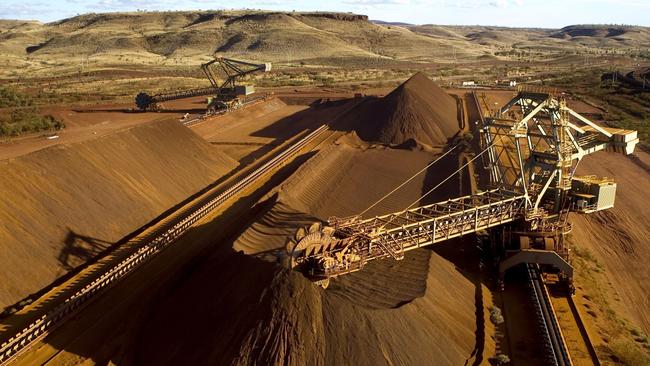Rio Tinto lifts iron ore shipments but downgrade woes widen
Rio Tinto’s alumina and bauxite operations have joined the list of the mining giant’s downgrade woes.

Rio Tinto has downgraded expectations for its alumina and bauxite operations, as the company ponders the future of its Australian operations in the face of high energy prices.
The mining giant said discussions with “stakeholders” were ongoing over energy costs at the troubled operations, which are on “thin ice” according to Rio boss Jean-Sebastien Jacques.
He told reporters at Rio’s half-year results in August its smelters at Gladstone and Newcastle faced possible closure if a fix for soaring power prices was not found, and the company on Wednesday downgraded production expectations for the division, citing maintenance work and a “challenging conditions in global markets and policy uncertainty”.
The company said it expected its share of alumina production to be about 7.7 million tonnes, down from 8.1 to 8.4 million tonnes in previous guidance.
Rio said the downgrade was primarily attributable to its Australian refineries, with cuts to its share of bauxite production, now expected to be 54 million tonnes in 2019, down from 56 to 59 million tonnes.
Rio lifted its sales of raw bauxite ore to third-party buyers in the September quarter, to 10.4 million tonnes — up 9 per cent on the June period and 23 per cent compared to the same quarter in 2018.
Its share of alumina production was 1.8 million tonnes for the period, down 7 per cent from the previous year, with aluminium production also down slightly at 789,000 tonnes.
And while its iron ore operations have recovered somewhat from a poor first half of the year, the company is shipping increased volumes of lower-grade material into the market. Rio Tinto shipped 6.7 million tonnes of lower-grade products in the September quarter, a big jump in the portion of lower quality material the iron ore major is exporting.
After a poor first half of the year, total exports from Rio’s Pilbara mines lifted to 87.3 million tonnes of iron ore for the period, 10 per cent higher than the June quarter.
But 6.7 million tonnes of that was “alternative products” — lower-grade material as Rio struggles with mine sequencing issues at its Brockman operations — up from 2.4 million tonnes in the June period.
While the shipments will have some impact on Rio’s full-year earnings it is likely to be limited, given the company is shipping the product into a strong pricing environment in which discounts for lower-grade ore have narrowed compared to benchmark pricing for iron ore grading 62 per cent.
Rio maintained its full-year iron ore production guidance of 320-330 million tonnes, with costs of $US14-$US15/t.
Rio’s Mongolian copper operation also struggled as its Oyu Tolgoi mine moved to lower-grade sections of the open pit as the company looks to kickstart its troubled plans to move mining to an underground block cave model.
The company said it was still on track to complete a redesign of the first stage of the Oyu Tolgoi underground by early 2020, with the final cost and scheduling estimates still due by the second half of the year.
Rio’s share of output at Oyu Tolgoi fell 28 per cent from a year earlier to 9500 tonnes, with production at Escondida in Chile up 4 per cent to 90,500 tonnes and Rio’s Kennecott operations in the US falling slightly to 57.800 tonnes, down 2 per cent.
Total mined copper production was down 1 per cent compared to the third quarter of 2018, but 15 per cent up on the June period on higher grades at Kennecott and improved throughput at Escondida.
Ord Minnett analysts said the quarter’s result was a strong performance and “likely higher than market expectations”.
“Lower bauxite and alumina guidance is disappointing but not material in our view,” they said in a client note on Wednesday.
Rio Tinto shares closed down 0.9 per cent on Wednesday, at $89.81.


To join the conversation, please log in. Don't have an account? Register
Join the conversation, you are commenting as Logout